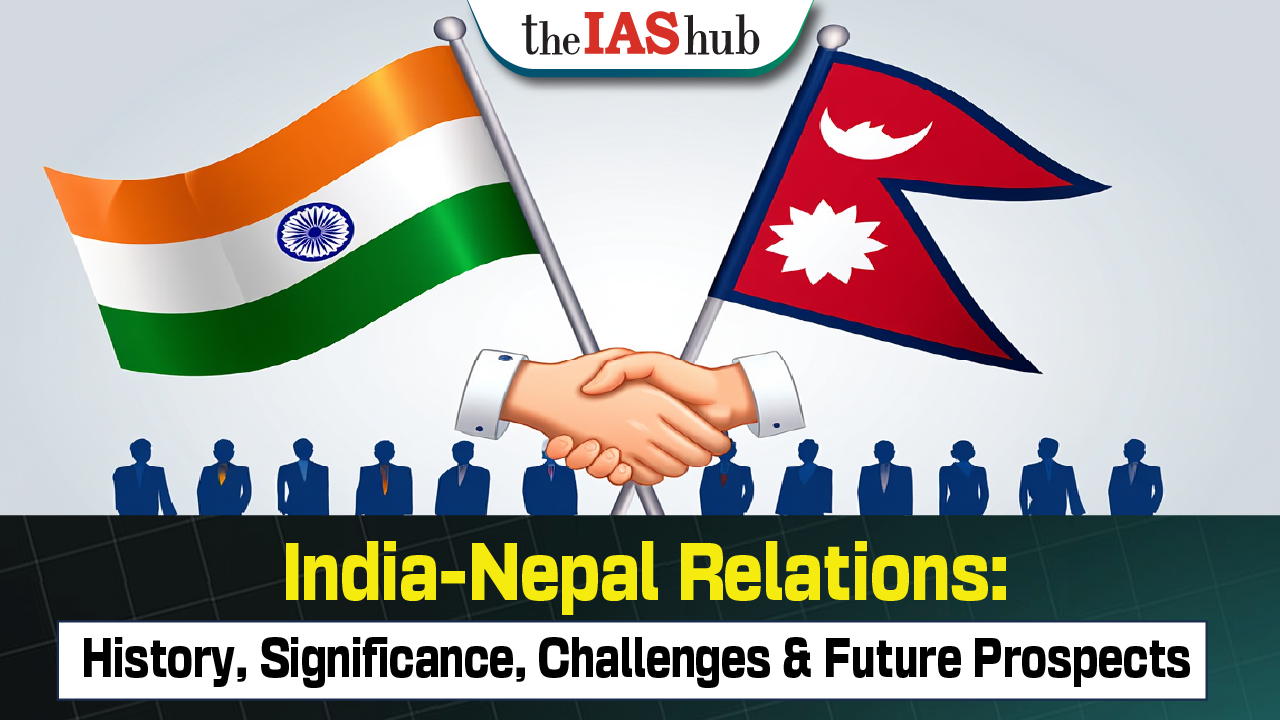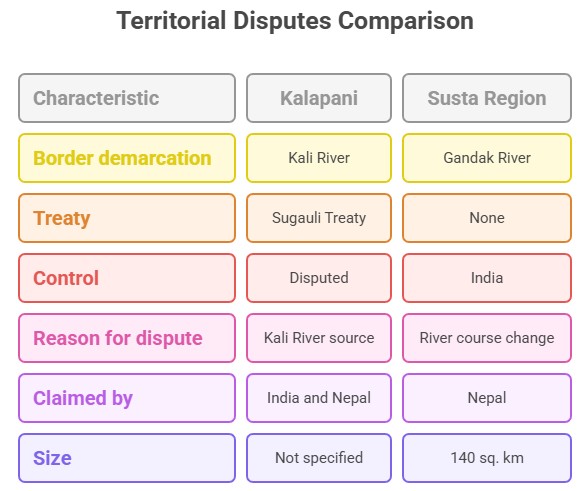India-Nepal’s Relation was founded on the age-old connection of history, culture, tradition and religion, these relations are close, comprehensive and multidimensional and are pronounced more in political, social, cultural, religious and economic engagements with each other. The two countries established diplomatic relations on 17 June 1947.

Significance of Nepal for India
Economic Significance
- Trade: Nepal's geographical proximity to five Indian states makes it an important trade partner for economic exchange.
- Energy security: India and Nepal share transboundary Himalayan rivers with immense hydropower potential.
- Nepali exports: India has a significant demand for Nepali exports, particularly Pashmina textiles. India exports to Nepal was US$8.53 Billion during 2022.
Strategic Significance
- Buffer state: Nepal serves as a buffer state against possible aggression from China.
- Internal Security: Nepal's cooperation is crucial in curbing cross-border infiltrations and drug trade.
Cultural Significance
- Pilgrimage sites: Nepal's numerous Hindu and Buddhist religious sites attract a large number of Indian pilgrims.
- Common religion: Both countries have a Hindu population of around 80%, which promotes cultural integration.
- Diaspora: There is a significant Nepali diaspora in India, while Indian workers contribute to Nepal's workforce.
Bilateral Relationship in India-Nepal Relations
- India and Nepal share a unique friendship characterized by an open border and deep-rooted people-to-people contacts based on kinship and culture.
- India's focus on Nepal revolves around non-partisan support for inclusive economic development, interdependence, communication links, people-to-people contacts, and capitalizing on economic complementarities, particularly in the hydropower sector.
- The historical, geographical, cultural, religious, and economic linkages between India and Nepal help manage security concerns within acceptable limits.
Economic Relationship in India-Nepal Relations
- Trade: India is the Nepal's largest trade partner, contributing to more than two-thirds of merchandise trade.
- Investment: Indian firms constitute a significant portion of foreign direct investment in Nepal, accounting for over 30% of the total approved investments.Approximately 150 Indian ventures are operating in Nepal.
- Agriculture: In 2018, the 'India-Nepal New Partnership in Agriculture' was launched to foster collaborative projects in agricultural research, development, and education.
Water Resource Cooperation: A bilateral mechanism established in 2008 facilitates discussions on cooperation in water resources, flood management, inundation, and hydropower.
- Nepal has decided to allow India’s Satluj Jal Vidyut Nigam (SJVN) Limited to develop a second hydropower project in the country. At present SJVN is developing a 900-MW Arun -III hydroelectric project, a run-of-river located on the Arun River in Eastern Nepal, set to be completed in 2024.
- In 2022, both nations signed MOU’s to develop the West Seti and Seti River (SR6) projects to enhance the cross-border power exchanges.
|
Defence and Security in India-Nepal Relations
- India has been assisting the modernization of the Nepal Army by providing equipment and training.
- Nepalese defense personnel attend training courses in various Indian Army institutions.
- The 'Indo-Nepal Battalion-level Joint Military Exercise SURYA KIRAN' is conducted alternately in India and Nepal.
Connectivity and Development in India-Nepal Relations
- The Nepal-Bharat Maitri Pashupati Dharamshala in Kathmandu was inaugurated in 2018.
- Bangladesh, Bhutan, India and Nepal (BBIN) Motor Vehicle Agreement for the Regulation of Passenger, Personal and Cargo Vehicular Traffic.
- The establishment of Integrated Check Ports along the borders, including Birgunj and Biratnagar, has facilitated trade and transit.
Energy in India-Nepal Relations
- India and Nepal have had a Power Exchange Agreement since 1971 to meet the power requirements in border areas, utilizing each other's transmission infrastructure.
- Currently, India supplies approximately 600 MW of power to Nepal.
- The first high-capacity cross-border power transmission line between Muzaffarpur (India) and Dhalkebar (Nepal), with funding from the Government of India, was completed in 2016.
- An agreement on 'Electric Power Trade, Cross-border Transmission Interconnection and Grid Connectivity' was signed between India and Nepal in 2014.
Education and Culture in India-Nepal Relations
- Approximately 600,000 Indians reside in Nepal.
- The Government of India provides around 3,000 scholarships annually to Nepalese nationals for various courses.
- The B.P. Koirala India-Nepal Foundation was established in 1991 to promote educational, cultural, scientific, and technical cooperation between the two countries.
- The Swami Vivekananda Centre for Indian Culture, set up in Kathmandu in 2007, showcases Indian culture.
Challenges in India-Nepal Relations
Territorial Disputes
Kalpani
- The Kali River in the Kalapani region demarcates the border between India and Nepal.
- The Treaty of Sugauli signed by the Kingdom of Nepal and British India (after the Anglo-Nepalese War) in 1816 located the Kali River as Nepal’s western boundary with India.
- The discrepancy in locating the source of the Kali River led to boundary disputes between India and Nepal, with each country producing maps supporting its own claims.
Susta Region
- It is about 140 sq. km of land in Uttar Pradesh at the Nepal border in the Terai area. India has control of the territory. Nepal claims this territory.
- The change of course by the Gandak River is the main reason for disputes in the Susta area.
Issues with Peace and Friendship Treaty
- The 1950 Treaty of Peace and Friendship is viewed as a sign of an unequal relationship and an Indian imposition.
- The idea of revising and updating the treaty has been mentioned in Joint Statements but progress has been sporadic.
The Demonetization Irritant
- In November 2016, India withdrew high-value currency notes, and many Nepali nationals who were legally entitled to hold Indian currency were left without a way to exchange their demonetized bills.
- The Nepal Rastra Bank holds a significant amount of demonetized Indian currency, and the fate of the report submitted by the Eminent Persons Group (EPG) remains unknown.
China's Intervention
- China has gradually increased its influence in Nepal, filling the space left by India.
- China sees Nepal as a key partner in its Belt and Road Initiative (BRI) and wants to invest in Nepal's infrastructure.
- The growing cooperation between Nepal and China could undermine Nepal's position as a buffer state between India and China.
Internal Security
- The lightly policed Indo-Nepal border poses a major concern for India, as it can be exploited by terrorist outfits and insurgent groups from the north-eastern part of India.
Trust and Ethnic Differences
- Trust deficit has widened between India and Nepal due to perceived delays in implementing various projects.
- Certain ethnic groups in Nepal harbor anti-India sentiments, believing that India interferes too much in Nepal's internal affairs.
Solutions
- Mutual empathy: There should be a willingness among political leaders, bureaucracies, and civil society on both sides of the border to understand each other's perspectives.
- Diverse and balanced approaches: A clearer understanding of the past, present trends, and new roadmaps for upgrading ties should be developed.
- New and innovative approaches: India should respect Nepal's identity and work towards a sense of equality.
Way forward
- Dialogues for Territorial Disputes: Rhetoric on territorial nationalism should be avoided, and quiet dialogue should be initiated to explore feasible solutions. India should be a sensitive and generous partner.
- Sensitizing Towards Nepal: India should engage proactively with Nepal through people-to-people interactions, bureaucratic engagement, and political interactions.
- It should maintain a policy of non-interference in Nepal's internal affairs.
- Strengthening Economic Ties: The power trade agreement should build trust between India and Nepal, as hydropower can effectively manage peak demand in India.
- Investing in Nepalese hydropower can save the need for building new power plants and reduce pollution.
- Investments from India: Nepal should welcome Indian investments and address concerns raised by certain groups opposing foreign investments.
Conclusion
India and Nepal need formal mechanisms to resolve boundary issues, drawing inspiration from successful resolutions in other regions. People-to-people interactions and updated discourse are crucial, considering Nepal's federated governance and changing demographics.













